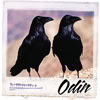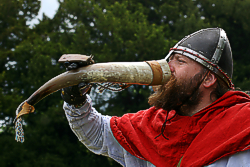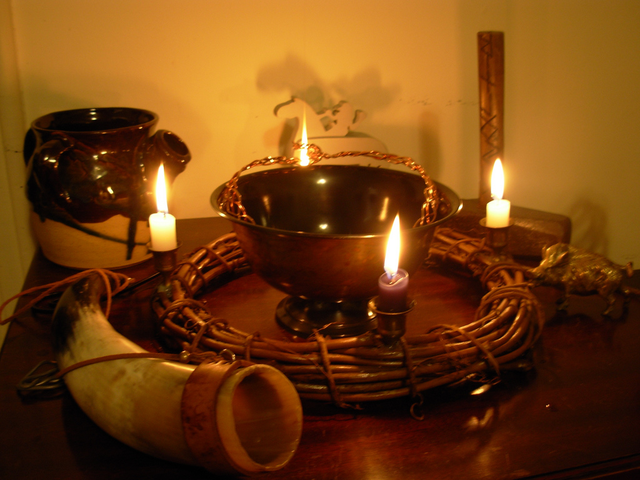This week I thought I would write about something in an exploratory way. It’s a topic that I know a bit about but nothing  in depth since it’s a celebration I’ve had the opportunity to participate in a few times as a kindred guest. So I’m looking forward to some comments from those who are on more of a Norse Pagan or an Ásatrú path. It’s the celebration of the blót.
in depth since it’s a celebration I’ve had the opportunity to participate in a few times as a kindred guest. So I’m looking forward to some comments from those who are on more of a Norse Pagan or an Ásatrú path. It’s the celebration of the blót.
In the Norse traditions the blót, which is pronounced as you might things, bloat, is a meal or feast that has a sacrament aspect to it. A sacrifice is made and gifts of energy and blessings from the Gods are received. The two that I have attended also included another ritual as part of it called a sumbel. I’m not going to go in depth on the sumbel here because I’m planning to cover that during an S week later in the year, but it’s basically rounds or ritual toasting. From what I’ve learned from both my study of Ásatrú and from my personal experience a blót can include a full sumbel or it can simple include one or two rounds that toast the Gods and heroes or ancestors.
Blóts take place at the holidays and at some other special feast dates for certain Gods. The name blót is an Old English derivative of the Proto-Germanic word “blótan” meaning “sacrifice, worship”. This is the real core of the blót; it’s main function is to offer up a sacrifice to the Gods. This has changed over the centuries from animal sacrifice (and at one time human sacrifice, which has been especially suspected to have been part of blóts with the Vikings) to now consisting of a sacrifice in the form of something that has been very carefully crafted for the Gods. Most commonly this is either mead or ale that has been brewed specifically with the sacrament of the blót in mind.
There are several “Ásatrú; The Hidden Fortress”, Edred Wodanson (the late E. Max Hyatt who passed away in January 2010). lays out a basic blót along with a full blót to Odin. He says that while a blót can be long and involved there are really five core aspects of a proper blót.
- The Banishing – The first step is just as it sounds; the space where the rite is to beheld is cleansed and any negative energies are banished. It is extremely important in the process of the blót for the space to be sanctified and made fit for the Gods to be present in.
- The Calling – This is the calling of the Gods, done in a strong and bold manner, calling to one’s Ancestral Gods to invite them to be present. He makes a big point of stressing that this should be a “knee-bending” type of invite, but something done with force and strength, but again an invite, not a command. The belief that he has, and that many who follow a similar practice have, is that when called the Ancestral Gods will come. (As an aside, and if anyone can correct me on this, please do, but from having read Edred Wodanson’s books I believe that the type of Ásatrú that he practiced and wrote about was more of an ancestral based practice…and I use that term rather than nationalist because I don’t know that he was that extreme, but he did seem to stress the idea that to practice Ásatrú you need to have Germanic roots that tie you to the Norse Gods by blood…a view that is not at all uncommon in Ásatrú as opposed to the more eclectic Norse Neo-Pagan practices).
- The Sacrifice – This was most traditionally an animal sacrifice to the Gods. It was the idea of giving life essence to receive life essence. From talking to practitioners that live in rural areas and who raise their own animals for food I have been told this is still a common practice, but for most modern day practitioners the sacrifice consists of something that has been carefully and meaningfully crafted with a great deal of energy and intention for the Gods. Holy mead and ale which will be used in the blót itself is the most common thing used. The mead is blessed to make it sacred and then it is offered up to the Gods. In the blóts I have attended this is done with a full horn of mead, the first horn poured from the bottle, and the horn is offered to the Gods and then poured into a special offering bowl and left on an altar for them throughout the rite of the blót.
-
The Gift – This is the process of receiving a gift from the Gods. Unlike in some Pagan traditions where receiving gifts from the Gods is never expected in Ásatrú there is an exception that the Gods will reciprocate when they are given a gift and offering. One of the texts that are important in Ásatrú is the Havamal, which is a sacred poem from the Poetic Edda. In the Havamal is a section called “Odin’s Rune Song” and in the eighth stanza of the poem it says:
“Better don’t ask than offer too much;
A gift demands a gift.
Better send none than slay too many.”So there is an expectation that through the sacrifice a gift will be given in return from the Gods. This comes in the form of energy which is infused into the mead and then dispensed to the participants through drinking the mead while toasting the Gods. In times past, and even today where animal sacrifices are still done, the gift is given by energy that is passed from the Gods into the blood and meat of the animal. The participants are anointed with the blood, the space is sprinkled with the blood (or if outdoors it is poured into the earth) and then the meat is cooked and consumed as part of the feast and when consumed the energy is again passed on to those present.
During The Gifting, is a sumbel is to take place, it happens here. - The Farewell – Once the offerings and feasting is done the Gods are thanked and then released. Any other energies or wards that have been brought in are also dispersed after proper thanks.
Diana Paxson also lays out a common outline for a blót in her book “Essential Ásatrú” that seems to be fairly similar but with a few more steps specifically noted which in Wodanson’s outline are likely part of the process just not specifically outlined. Paxon lays it out as:
- Preparation: Setting up the space, banishing work, warding, setting up the altar, and making an offering to the spirits of the House (if indoors) or the Land (if outdoors).
- Focusing: A statement of intent from the rite leader is made to explain the purpose of the blót and to lay out and special steps or instructions that will be important for participants to know ahead of time.
- Invocation: This is the same as the calling; the Gods are called to be part of the rite through prayer.
- Offering: This is the same as Wodanson’s Gift step. An offering is made to the Gods but she explains a bit more of a Neo-Pagan concept with this. Paxon outlines not only the possibility of mead or ale being given but also singing, chanting, the telling of stories and myths, or the enacting of ritual drama as being possible gifts to the Gods.
- Sharing: Here she calls this “sharing” but it is basically a sumbel. The horn of mead is passed around in successive rounds. Round one everyone hails the Gods, round two hails heroes and ancestors, and round three honors anyone, living or dead, that the individuals feel deserve a mention. At the end of each round any mead or ale left in the horn is poured out into a special offering bowl on the altar for the Gods and it is then refilled with new drink for the next round. The intention is to keep some in the horn so that an offering to those mentioned in that round is made at the end. Again, I’ll be talking more about sumbels, a ritual I’ve had the pleasure of attending a handful of times, later in the year.
- Completion: Here Paxson explains the closing of rite prior to the feasting. Gods are thanked and released, wards released etc.
The blóts I have attended have been an interesting mix of the two. The most notable difference from my experience has been in how Paxon describes steps 4 and 6. My experiences with these rites, and in those steps, have been like what Wodanson explains. The offerings I have seen have never been in a bardic form. They have been the offering of mead or blood. I have also never attended a blót where the feast was separate from the rite. The feast is the rite. The meat that is eaten, whether it was sacrificed for the rite or if it was purchased, blessed, and made holy for the rite, is still considered part of the blót itself, not a separate post ritual feast as we often see in many Neo-Pagan and Neo-Wiccan gatherings.
In my experience blóts are a fantastic thing to be part of. They are powerful rites of community and worship. When I was exploring the Ásatrú tradition and attending some rituals, events, and classes with friend who were already practicing this tradition, I was completely amazed by the community gatherings. They were more like a true gathering than feeling like some sort of sacred religious where everyone had to be solemn in some way…though there was certainly a sacredness to what was happening! I remember having attended a blót with some friends and then a handful of days later attending a full moon ritual with the Wiccan group I was with at the time. A friend in that group had also attended the blót as a guest. We stood there in circle, feeling the energy that was being raised, and it made us both being to smile and eventual let out a giggle. A woman a few people down from me whipped her head around and glared at me and said “This is a sacred space! This is NOT a place for giggling!”
That kind of gave me some pause and had me thinking about the more free feeling that was part of the atmosphere of the blót I attended. But, in all honesty, that particular woman had only attended a few events with this Wiccan group and she didn’t come to many more. I believe very strongly that the energy in a circle and during a ritual can take many different forms and you should express it how it comes out through you. Sometimes that’s laughing, sometimes it’s crying. Sacred space IS the place for laughter and tears! Things like this was one of the many reasons that I eventually started my own coven.
I ended up not joining a kindred and following the path of Ásatrú, but as someone with Germanic heritage, I do feel a connection to the Norse Gods and many of the practices within Ásatrú. I love blóts and sumbels and we practiced them in my own coven as part of our mixed Norse and Celtic tradition based on the things that I have learned through study and from the events I’ve attended. Obviously there are bits and pieces probably missing given I haven’t been part of a kindred before.
I would love to hear more from any Norse Pagans about your experiences with blóts and learn more about them. I know my knowledge and experiences is limited, and there are bits and pieces I probably didn’t cover (like blessing with the sign of the hammer and all that) but I’d love to hear any insights any Ásatrúars, Heathens, or Norse Pagans might have to share!







I wrote about one of my first Blot experiences this week myself. It isnt very detailed because my memory isn’t entirely clear. http://treegoldandbeegold.blogspot.com/2012/01/pagan-blog-project-my-first-yule-blot.html
I’ve participated in many more through the years since. In my experience the Blot itself is often very simple. I have never stood very high on ceremony though. 🙂